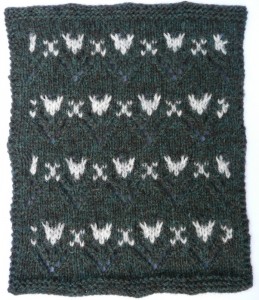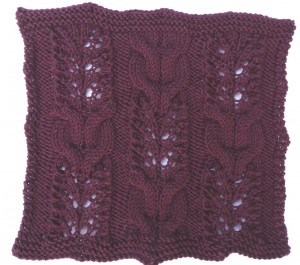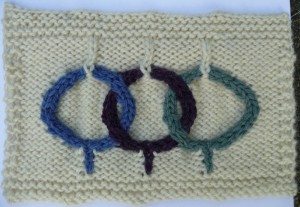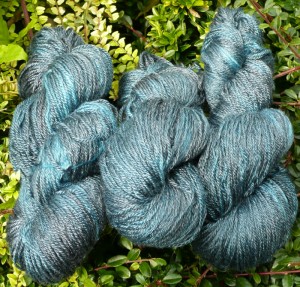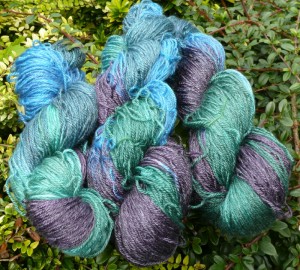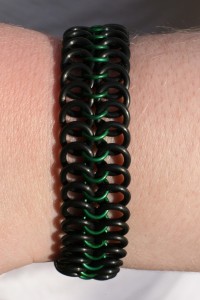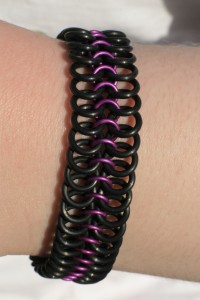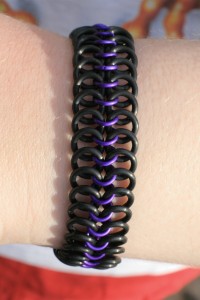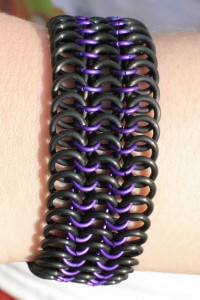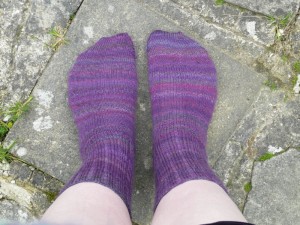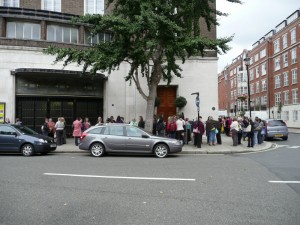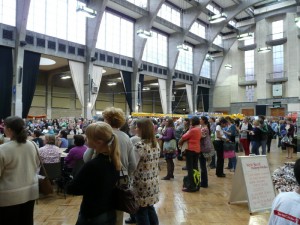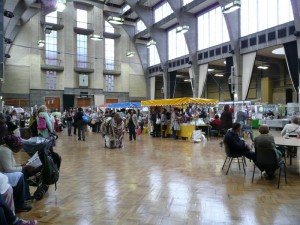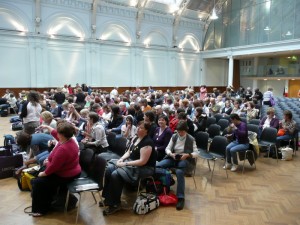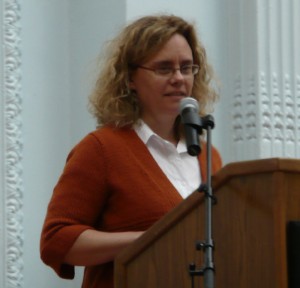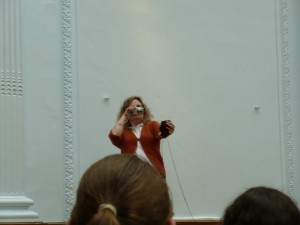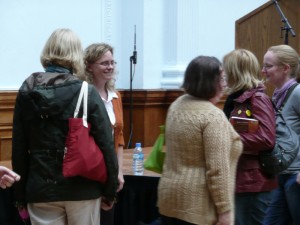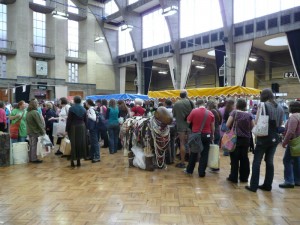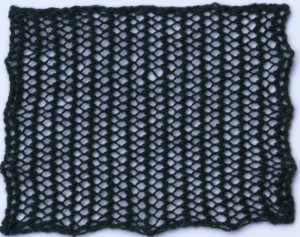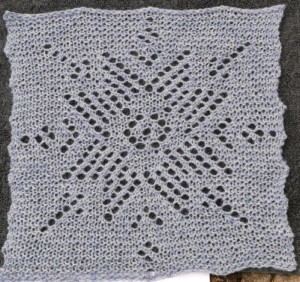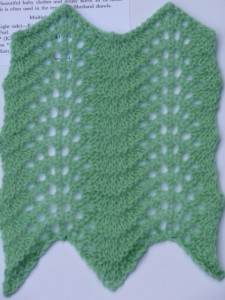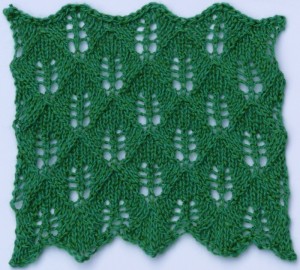Thanks for your email. I tried to reply to you but got a message saying that I am not one of your allowed list of rcpthosts, and that the message couldn’t be delivered. Could you add me to your list of allowed rcpthosts and then let me know and I will email you again. Thanks!
Author Archives: Heather
Combined stitch structures
Apologies for no post on Monday, and that today’s post is rather later than usual. We have been down to Cornwall for a couple of weeks which was lovely, so the last three posts were brought to you by the magic of post-scheduling. However I haven’t been very quick at getting things sorted out once we got back, although we now have clean clothes which is a good thing.
September’s City and Guilds knitting homework was combined stitch structures. All of my examples come from the 1000 Knitting Patterns Book.
First up stranded knitting and lace, with a few slipped stitches thrown in too.
Next some cables and lace.
And finally some intarsia, a little bit of stranding and cables. The original pattern for this was in just one colour, and had a mixture of garter stitch and reverse stocking stitch for the background. I changed it to use all reverse stocking stitch and to introduce the colours. The rings are worked in intarsia, but the background is stranded across the back of each ring.
These were the last set of samples to complete the sample portfolio, and I handed in the whole lot (all 5 lever arch files of it!) at the class on Sunday. This is the first piece of work that I have had formally assessed for this course although Fiona has been checking our work as we go along to make sure we haven’t got completely the wrong end of the stick. It is nice to finally hand something in officially though, and I think it will be useful to have a bit of feedback on it all before I am too far along with all the other parts. It is always hard to know exactly what is expected on a new course until you get your first piece of work assessed. I am miles behind on the projects though so I had better go and get a move on with them!
More dyeing experiments
I have been doing some more experimenting with dyeing, and the novelty hasn’t worn off yet. I think this may well blossom into another fully-fledged addiction.
This time the yarn I have been dyeing is 50% superwash merino, 50% tencel, 4ply / fingering weight, again bought from H W Hammand. I also wanted to experiment with dyeing a greater quantity of yarn in one go.
So first of all, three 100g skeins dyed with Jacquard acid dyes, using citric acid.
Secondly another three skeins, using Jaquard acid dyes again, but this time using vinegar.
I cooked them both in a steamer I bought a few weeks ago specially for the dyeing. I was concerned that my microwave might not be heating the yarn evenly so thought I would give the steamer a go. Also the nice thing with the steamer is that it doesn’t require monitoring, it has a timer so I can just put it on and then go and do other things.
It was really interesting to see how the different fibre took the dye. The yarn is lovely and shiny but the colours aren’t as bright as on the 100% wool, and they seem to have a grey cast to them, particularly the teal. These are destined to be a couple of shawls, and I am really looking forward to seeing what this yarn is like to knit with.
Chain Maille
In a little departure from the knitting I have been having a play around with chain maille bracelets made from rubber O rings and anodised aluminium jump rings.
It is such a lot of fun, although it does take a bit of practice to get used to holding a pair of pliers in each hand.
The rubber rings give the bracelets an interesting tactile quality, and are also slightly stretchy, allowing you to make a comfortable bracelet without a fastening, but which doesn’t fall off.
I got the o-rings and the jump rings from Bead Sisters, along with a very useful book called Chain Mail Jewelry, which is suitable for the total beginner but still manages to cover a lot of different techniques.
Purple socks
These are another pair I finished a little while ago and have only recently got round to photographing (I have nearly caught up with myself!)
The yarn is Admiral dégradé by Schoppel Wolle, colour 1309 bought from Knit n Caboodle. This is very similar to Trekking in the long colour sequences, and the way that it is made up of 4 threads which each change colour gradually at different points. The pattern is my usual ribbed sock pattern with short row heel and gussets in the leg and foot.
I love the colour of these so much 🙂 Socks in shades of purple, what more could I ask for?
I Knit Day
On Saturday I went to the I Knit Day at the Royal Horticultural Halls in central London.
Wow! What a day! Luckily the start was not too appallingly early, and the rain decided to give us a respite (at least for a while). I’m afraid I’m not a big fan of London, I find it dirty and smelly and crowded, and I don’t really do well in crowds, but it is worth putting up with occasionally, especially if there is a good knitting reason 🙂
I was very fortunate with the trains, and although all the trains from my station to Waterloo had been cancelled and replaced by buses the ones to Victoria were running on time. After a few minor navigational errors (you would hardly realise that I actually worked the other side of Victoria for 8 months, although I hadn’t ever been to the Horticultural Halls before), I made it to the halls at 10.30. The show opened at 11am, but I like to be early for things and half an hour was perfectly reasonable, and I wasn’t the first person there either!
The other people in the queue were very nice, and we all chatted and admired each other’s knitting, and before long there were quite a few of us, doing what the British love to do – forming an orderly queue, and doing what bloggers love to do – photographing it.
The rain took pity on us and held off until the doors opened, where we were confronted with this:
The first one was actually taken at lunchtime when things were a bit busier than they were first thing, and the second was taken shortly before I went home.
There were a good number of stands to look at and nice wide aisles between them so that you could easily get past even when the stands themselves were very busy. The only downsides were the acoustics, and the seating at lunchtime. I went to Jane Sowerby‘s talk and despite us all shuffling our seats forward and me only being a few feet from her, due to the echoeyness of the hall and the background noise I could hardly hear a word she said. I could see her beautiful shawls though, and later helped to fold them all up, I have a couple of her shawls in my ravelry queue, and I am really looking forward to knitting them. Then later during the fashion shows the microphone was turned up so loud that it was very hard to have a conversation even at the other end of the hall. Seating is always a problem, probably because everyone always wants to sit down and eat lunch at the same time, yet you don’t want the whole hall to be full of empty chairs the rest of the time. I stood up to eat lunch while watching one of the fashion shows but my feet were not friends with me by the time I got home.
The highlight of the day was the talk by Stephanie Pearl-McPhee. This was in a separate hall – unfortunately over the road so more queueing in the rain. Here is the hall starting to fill up:
And here is the lady herself:
And the obligatory sock picture:
She was good fun and interesting, although I haven’t had the negative experience she seems to have had when attempting to explain knitting to my friends and family. Perhaps it is just that they are immune by now?
She kindly stayed behind after her talk and chatted to people. I followed the lady in the gold cardigan in this picture back over the road to the main hall, and am now kicking myself for not running a bit faster and saying how beautiful it was and asking what the pattern was.
We all trundled back off to the main hall and Stephanie signed millions of books. Here is the queue for her signing, I think this was after she had already been signing a couple of hours. I do hope she wasn’t there all night.
As well as listening to the talks, one of the delights of days like these is meeting up with other knitters, some of whom I have met before and some not. I’m afraid I will not be as organised as Katie and list them, because I have an appalling memory and it would be embarrassing the number of people I left out. Suffice it to say, I had a wonderful time, and it was lovely to see everyone (again).
I was remarkably restrained in the shopping part of the day. I came home with some lovely undyed yarn from H W Hammand, and nearly my own body weight in fudge (not inconsiderable, I can assure you, as the Wii-fit keeps pointing out to me), and other than that had a lovely time looking at everything and pondering. I love these opportunities to squish all the yarn and see what the colours are really like. Even if I don’t buy stuff on the day I come home with the information tucked in the back of the brain which will whir round and hopefully pop out in a useful manner at some point in the future.
The length of the day felt about right for the shopper, but must have been very long for the stall-holders, some of them had been up obscenely early setting everything up – I hope they sold lots and it was worthwhile. I admitted defeat a little after 6 (the show closed at 7pm), and was fortunate in not having to wait too long for a train home. It did start raining in time for me to get off the train and walk home but wasn’t too bad, and I am hoping that the brisk walk will combat some of the fudge I am now going off to eat 🙂
Lace
The homework for our August City and Guilds class was lace.
The first sample is an example of faggoting, that is, a lace mesh.
This pattern is called Basic Faggoting Stitch and is from A Treasury of Knitting Patterns by Barbara Walker.
The second sample is an example of a pattern made with eyelets.
This is a snowflake from Gossamer Webs: The History and Techniques of Orenburg Lace Shawls by Galina Khmeleva and Carol R. Noble. There were a couple of little errors in this chart so if you are interested in knitting any of these patterns I would recommend downloading the errata first (although neither of the errors I spotted were actually included in the errata, I have contacted them so hopefully they should appear in the next version of the corrections). In 2000 Mummy and I went on a fascinating weekend workshop in Bradford organised by the Knitting and Crochet Guild on Orenburg shawls. It was really interesting and a wonderful weekend, I am looking forward to getting round to doing my own Orenburg shawl at some point.
Next up is an example of Shetland lace.
This is Feather and Fan Stitch, I got the instructions from A Treasury of Knitting Patterns by Barbara Walker, but being a traditional pattern it is in a lot of books. This just goes to show that you can work lace in acrylic 🙂
Lastly, my fourth sample shows an example of a more complex lace pattern which distorts the fabric (if the decrease is not right next to the corresponding yarn over then the fabric will be distorted).
This is Fern or Leaf-Pattered Lace, again from A Treasury of Knitting Patterns by Barbara Walker. I do love this pattern, it tiles so beautifully. I must do a whole garment using this, it is such a lovely pattern, and very pleasant to knit.
I now only have one more set of samples to do, on combined stitch structures, and then I need to organise them all and hand them in. I am hoping to be able to hand in at the September class so I’d better get a move on!
Workshop on the Patchwork Knitting Techniques of Horst Schulz
I am very excited to announce that I will be helping Rosie Sykes and Jill Brownjohn to run a workshop on Horst Schulz‘s Patchwork Knitting Techniques in October. So the salient details:
When?
Saturday 4th October 2008, 9.30 – 5.00
Where?
Liston Hall, Marlow, Buckinghamshire, UK.
How much does it cost?
£35
What will I learn?
Rosie and Jill will cover the basics of mitred squares and joining them together, knitting strips and different joining methods, chevrons, shells, and combining these techniques with machine knitting. I will cover shaping within mitred squares, the methods I used when making my Patchwork Sweater. We we also all be talking about design ideas for what you can do with all these techniques.
How do I find out more / book my place?
Contact Jill Brownjohn for more information and a booking form at telephone 01628 471397. Unfortunately Jill’s email isn’t working at the moment, but you can email me for the booking form at heather@heatherknits.com.
Hope to see you there!
Japanese knitting books
A parcel arrived a little while ago containing some books I had ordered from Amazon in Japan.
They are all in Japanese, but have fantastically clear diagrams. I get the impression that I would probably learn even more if I actually could understand the Japanese, but the diagrams are numerous and well thought out enough that one can learn a lot just from looking at the pictures.
First, on the right is the Hand Knitting Techniques Book, which is really pretty self-explanatory. There are 80 pages, and it takes you right from how to form a knit stitch and a purl stitch, through casting on and off, decreases, increases and several fancier textured stitches. A lot of the techniques I already have descriptions of in other books, but I do find the diagrams in this book to be exceptionally clear. Also they really do illustrate every step of a stitch, with lines drawn on to show exactly where your needle or yarn should be going. There are also a few techniques, particularly some of the textured stitches that I haven’t come across in other sources. I found the approach to the cast ons very interesting. Although they only really demonstrate the tubular cast on and the long tail cast on there are lots of different variations, and how to work them in particular circumstances which I am looking forward to experimenting with.
Next is Clear & Simple Knitting Symbols. One of the nice thing about Japanese knitting patterns is that they have a standard set of symbols which every pattern uses. This book is basically a key for those symbols, along with diagrams of how to do them. There are 74 pages, and while it does cover casting on and off it is a lot briefer on the subject than Hand Knitting Techniques Book. It does show a knitted sample for lots of different stitches, along with the Japanese chart symbol for the stitch, and instructions on how to do it.
The last three are stitch dictionaries, Hand Knitting Original Patterns, Knitting Signs and Make Patterns, and 1000 Knitting Patterns Book. The 1000 Knitting Patterns Book also contains crochet. Inevitably there is some overlap between these books and ones I already own, but there are also some stitches in these that I haven’t seen before. Particularly interesting are the combined stitches, so fair isle and lace, or cables and lace. Also some interesting textures created by variations on knitting into the stitch of the row below, or of several rows below.
The postage from Japan is quite expensive, I imagine because books are quite heavy. All in all though I think these are a good addition to the knitting library. There are several stitch patterns I have earmarked already to have a play with, and I am also keen to experiment with the different variations on the tubular cast on, and on ways to close the gap on stocking stitch short rows.
Interruption
I am in the process of attempting to change website hosting providers. Hopefully this should all go nice and smoothly, but just in case it doesn’t, if things are a bit wobbly for a while then I am on the case, and hopefully I will get it sorted out soon.
More knitting related stuff soon.
